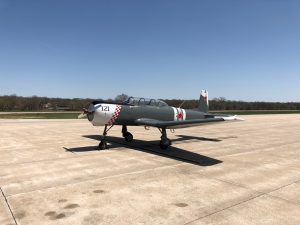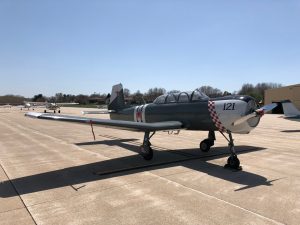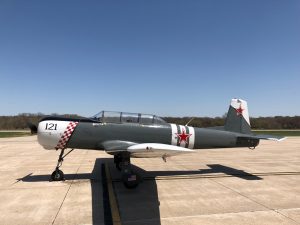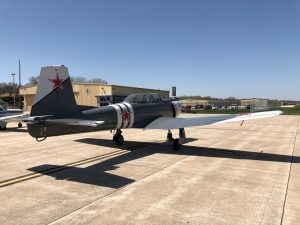K81 Ribb Run
With nice days upon us, what better way to spend it then doing a quick run for good BBQ down in Miami County KS. K81 sports a nice runway and some fine BBQ with ample portions that will leave you taking left overs to go.






Yak or CJ-6? KMLE
The more you hang out at the airport you may be surprised what you find on the ramp. On this fine April day we had a CJ-6 on the ramp that was beautifully restored. These were used by the Chinese as training aircraft and are commonly mistaken for a YAK 18A.
This fine aircraft is a CJ-6A which would be powered by a 285-hp Zhuzhou Huosai HS-6A radial piston engine. It was built in 1973 by Nanchang China registered as a Experimental.
- Is it a YAK or a CJ-6
- Is it a YAK or a CJ-6
February 2018 Safety Corner
It’s as simple as A, B, C, D, E . . . . .
When it comes to emergencies in the plane, these five letters can be a life saver. You probably remember them, while you toiled away earning your private license. If you don’t remember, I’ll give you a quick refresher.
Recently, Oracle Aviation had a couple of aircraft incidents that caused airplanes to land off airport. One was the result of a mechanical issue and the other, unfortunately, was a result of a pilot error. FORTUNATELY, neither incident resulted in any injuries or fatalities. The pilots in both planes did a good job of managing the actual off field landings because they were able to recall the emergency procedures taught during their initial training. The only way people walk away from off-field landings – regardless of the reasons why that happens – is because they follow the basics of:
A, B, C, D, E. When your engine quits, it’s critical that you do the following.
A – A is for airspeed. Know your best glide speed and NAIL IT! It’s important to reduce the freak out time to a few seconds and get this done right away. That will buy you time as you continue down the list.
B – B is looking for ‘best field’ or best landing option. Hopefully, it is a field where you have a lot of options. Since we are in the Midwest, we have a lot of rural areas. Every – thing looks fairly flat from the air but that’s not always the case. Look for agricultural fields that have straight rows of corn, beans, etc., and are not curved. All the curved fields are terraced, are not level, and also have varying degrees of elevation. Knowing the general wind direction in the area will be helpful in establishing a plan of action once you’ve chosen the field. If you don’t have the luxury of landing in a fairly open area or have to land in populated areas, pick the landing spot that may include green grass or an open area. You’re not going to have very much room for error so keeping any float or roll out to a minimum is critical. Managing your speed and rate of decent will be critical.
C – C is for checklist . YES, once you have your glide speed nailed and decided on a field (hopefully you have altitude to burn), pull out the old checklist to review emergency items. Remember to Squawk 7700.
D – Once the checklist review is completed, get on the radio to ATC (approach or center) and tell them what’s happening. Once you squawk 7700, they may already be trying to contact you. Give them your location and souls on board (if you have the 430 operating, choose the page that includes your lat and long info and pass that on to ATC). They will notify the appropriate authorities and get help to you as soon as possible. Remember, AVIATE, NAVIGATE, COMMUNICATE in that order.
E – Time to EXECUTE. This is where practicing pin-point landings, no flap landings, landing light out, 180 power off landings, etc., all come to fruition. Once you have briefed your passengers, concentrate on flying the plane to the ground and at the same time following your reviewed emergency procedures – gear down, wings level, fuel and electric off, and just do your best!
Concentrating on these steps will help eliminate stupid thoughts that run through many pilot’s heads in these situations . . . . . how did I get into this
situation, why me?, what’s everyone going to say?, will I lose my license?, how much is this going to cost?, etc. The ONLY thing you need to worry about is to get yourself and any passengers down in one piece and walk away. Planes can be replaced and egos can be smoothed, but your family only cares about you and those with you. Remember, people are not replaceable.
KEVIN BRODERICK, SAFETY OFFICER, ATP,CFII
January 2018 Safety Corner
In case you didn’t know….
1. Thirty seconds of cranking = 50 hours flight time wear.
2. Electrical loads will be heavier.
3. Don’t set parking brakes after heavy use of them – hot brakes will freeze solid. Let them cool first.
4. Idle at a little higher than normal rpm to keep plugs from fouling and oil hot.
5. Normal engine temperatures are necessary to evaporate moisture in crankcase.
6. Change tanks more often so that maximum fuel is available.
7. If RPM rises when carburetor heat is applied it could mean that air filter is
blocked.
8. Gyros will need to warm up and speed up, too. It’s not uncommon to see the AI cockeyed for a while.
9. Use radio only after electrical system has run a few minutes.
10. Keep in mind that braking on snow or ice may be poor to nil. You don’t have differential power like a twin engine plane to help keep you on the runway. If you land on ice, you’ll be at the mercy of mother nature and the laws of physics. This is why it’s important to call your intended destination AND check NOTAMs.
11. Keep power up during descents and extend any drag that may be available. This will keep the engine warmer.
12. Don’t use brakes until tires are on hard surface. Be prepared for ineffective braking. Touchdown areas of runways are more slippery.
13. If there is any slush on the runway, recycle the gear in the Arrow and Bonanza once you have lifted off. This will help knock off the slush and keep the gear from freezing in the wheel wells.
14. Ramp operations can cause ‘black ice’ problems for taxing.
15. Weather systems move more quickly in winter. Fast-moving winter systems create turbulence and hazardous conditions.
Performance:
1. STAY CLEAR OF ANY ICING CONDITIONS!!!
2. Just remember that your performance on runways may be less.
3. Reduce crosswind capability by 50% for snow and 75% for ice.
4. Just because no ice is forecast doesn’t mean there won’t be any. If you find yourself picking up any unforecast ice, change your altitude. This is where preflight preparations are critical. Know where warmer air is and where good VFR weather is.
5. If you find yourself in it, descend through ice at lower speed but high rate of descent.
6. Carburetor ice is far more likely to occur and cause an accident than is airframe icing. 51% of icing accidents are caused by carburetor ice or induction system ice. The cause of this ice is the failure of the pilot to ANTICIPATE the possibility of ice by applying full carburetor heat and alternate air. The fixed pitch plane will develop a rough engine while the constant speed plane is going to show a drop in rpm. Under icing the C.H. will increase the roughness of the engine. Leave it on. Use alternate air if available.
KEVIN BRODERICK, SAFETY OFFICER, ATP,CFII





